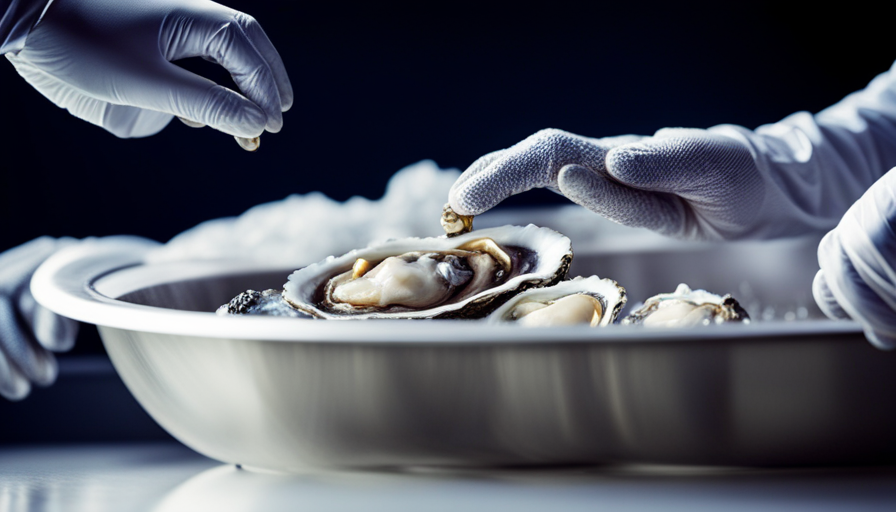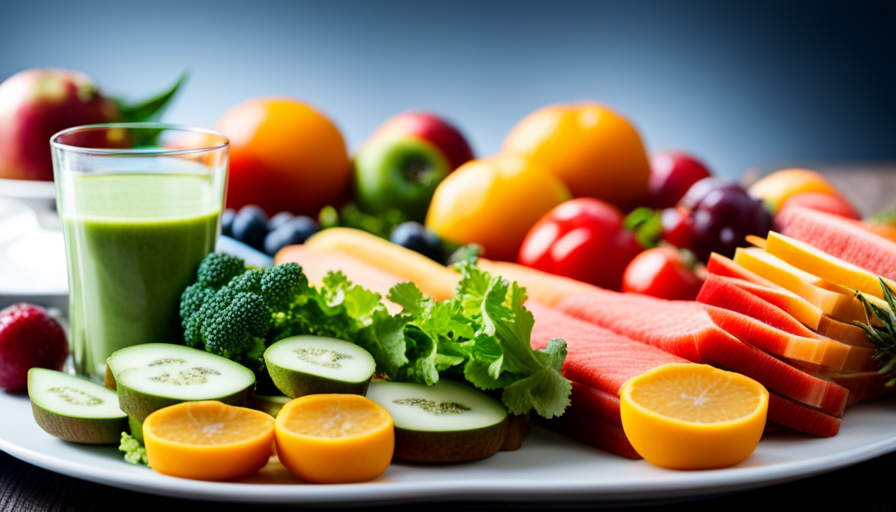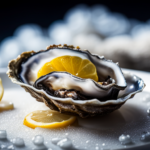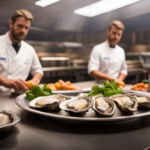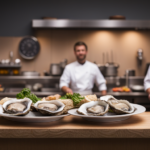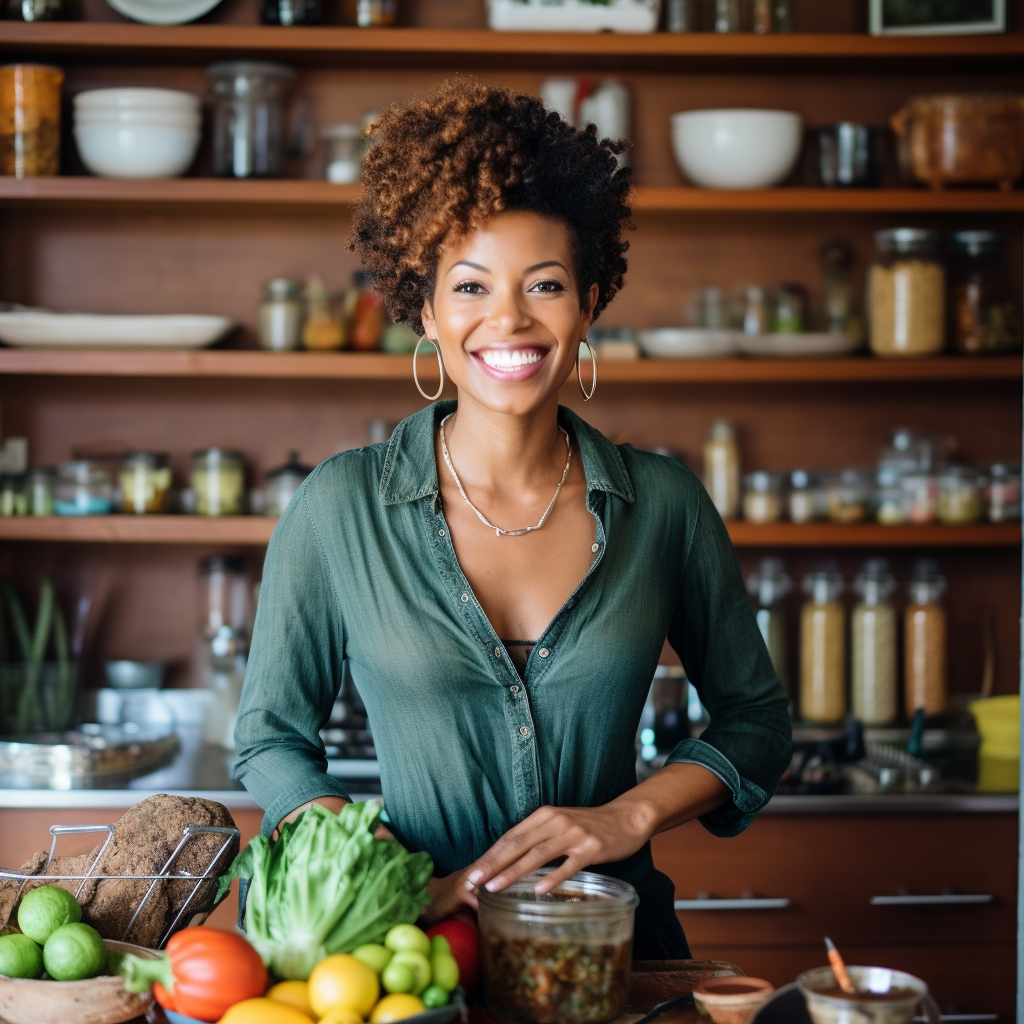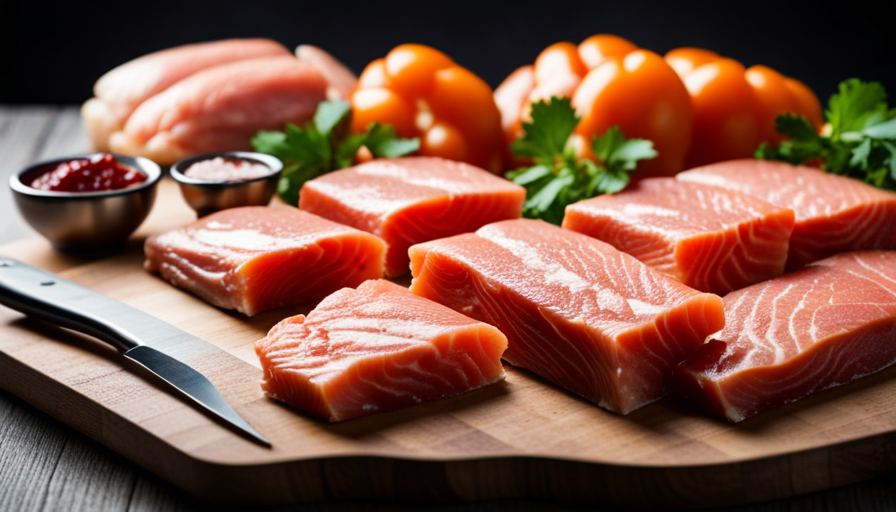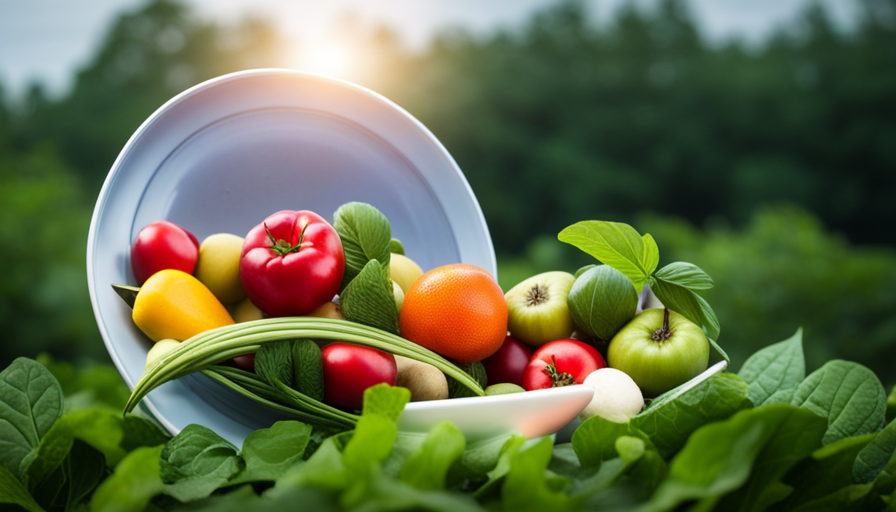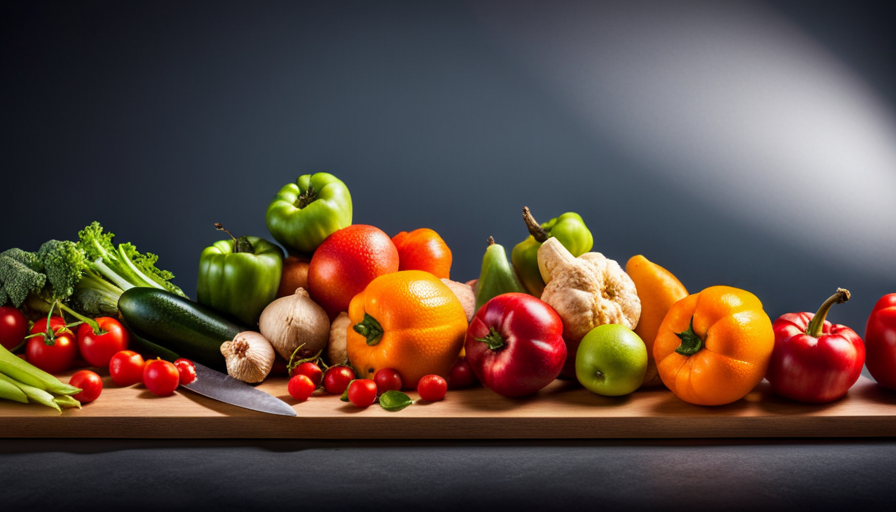Are you ready to enjoy the delicate and salty flavors of raw oysters, but concerned about the risk of foodborne illness? While indulging in raw oysters can be a delightful experience, it’s important to educate yourself on how to safely enjoy this delicacy.
In this article, we will guide you through the techniques and precautions necessary to fight off food poisoning from raw oysters, allowing you to savor these ocean gems without worry. Raw oysters can harbor harmful bacteria, such as Vibrio vulnificus or norovirus, which can lead to severe illnesses. However, by understanding the risks, practicing proper handling and storage techniques, and choosing fresh oysters, you can significantly minimize the chances of falling victim to food poisoning.
Additionally, we will explore cooking methods that eliminate harmful bacteria, recognize the symptoms of food poisoning, and discuss preventative measures for high-risk individuals. So, if you’re eager to dive into a platter of raw oysters with confidence, read on to learn how to enjoy them safely and responsibly.
Key Takeaways
- Purchase oysters from reputable sources that follow proper handling and storage procedures.
- Thoroughly cook raw oysters using methods like grilling, steaming, baking, or frying to eliminate harmful bacteria.
- Seek medical attention if experiencing symptoms of food poisoning from raw oysters, as prompt recognition and treatment are important.
- Practice safe handling and preparation of raw oysters to avoid cross-contamination and the risk of food poisoning.
Understanding the Risks of Raw Oysters
You need to be aware of the risks involved when consuming raw oysters, so you can protect yourself from potential food poisoning. While raw oysters can be a delicious delicacy, they also come with their fair share of dangers.
One of the main risks of consumption is the potential for foodborne illnesses, such as Vibrio infection. Vibrio bacteria can be found in oysters and can cause symptoms like diarrhea, vomiting, and abdominal pain. In severe cases, it can even lead to bloodstream infections, which can be life-threatening.
It’s important to note that not everyone who consumes raw oysters will get sick, but the risk is still present. This is why it’s crucial to take precautions when enjoying these mollusks. One way to reduce the risk is by ensuring that the oysters come from reputable sources that follow proper handling and storage procedures. Additionally, it’s essential to consume raw oysters as soon as possible after purchase and to keep them refrigerated until ready to eat.
Despite the risks, raw oysters also offer some health benefits. They are a good source of vitamins, minerals, and omega-3 fatty acids, which can promote heart health and boost the immune system. However, it’s important to weigh these benefits against the potential risks and make informed decisions about consuming raw oysters.
By understanding the risks and taking necessary precautions, you can enjoy raw oysters safely and minimize the chances of food poisoning.
Proper Handling and Storage Techniques
To ensure safe consumption, it’s crucial to properly handle and store oysters. Proper handling of raw oysters begins with purchasing them from a reputable source. Choose oysters that are tightly closed, as this indicates freshness. If the oyster is open, tap it gently and it should close; if it remains open, discard it.
Once you’ve selected your oysters, it’s important to keep them at a safe temperature. Store them in a refrigerator at a temperature below 40°F (4°C). It’s best to place them in a container with a lid, as this will prevent any potential cross-contamination. Additionally, it’s important to store oysters on ice to maintain their freshness and prevent bacteria growth.
When handling raw oysters, always use clean utensils and wash your hands thoroughly before and after touching them. Avoid exposing oysters to any other raw foods, such as seafood or poultry, to prevent the spread of bacteria.
By following these proper handling and storage techniques, you can minimize the risk of food poisoning from raw oysters.
Choosing Fresh and Quality Oysters
When it comes to selecting top-notch oysters, it’s all about finding the ones that are as fresh as a crisp ocean breeze. Oyster season plays a vital role in determining the quality and freshness of these delectable shellfish.
It is important to know when the oyster season is in your area to ensure you’re getting the best possible product. Different regions have different oyster seasons, so it’s essential to do your research.
Popular oyster varieties are another factor to consider when choosing fresh oysters. Some well-known varieties include Pacific oysters, Kumamoto oysters, and Eastern oysters. Each variety has its own unique taste and texture, so it’s worth exploring different options to find your favorite.
To determine if an oyster is fresh, there are a few things to look out for. Start by checking the shell. It should be tightly closed or slightly open and shouldn’t have any cracks or strong odors. The oyster meat should be plump and firm, with a clear and slightly briny liquid.
Remember, choosing fresh and quality oysters is crucial in avoiding food poisoning. By being knowledgeable about oyster season and popular varieties, you can ensure a safe and enjoyable experience when indulging in these ocean treasures.
Cooking Methods to Eliminate Harmful Bacteria
Get ready to discover some mouthwatering cooking methods that’ll ensure harmful bacteria are eliminated from your oysters, leaving you with a safe and delectable meal. When it comes to cooking oysters, it’s crucial to employ proper cooking techniques and maintain temperature control to kill any potential bacteria.
Here are some methods you can try:
-
Grilling: Fire up the grill and place your oysters on the hot grates. The high heat will kill any bacteria present while adding a smoky flavor to your oysters.
-
Steaming: Place your oysters in a steamer basket over boiling water. Steam them for about 4-6 minutes until the shells open. This method not only eliminates bacteria but also enhances the natural flavors of the oysters.
-
Baking: Preheat your oven to 450°F (232°C). Arrange your shucked oysters on a baking sheet and cook them for approximately 10-12 minutes. This method ensures even heat distribution, effectively eliminating harmful bacteria.
-
Frying: Dip your shucked oysters in a seasoned batter and fry them in hot oil until they turn golden brown. The high temperature of the oil will eliminate any bacteria, resulting in crispy and delicious oysters.
Remember, maintaining temperature control is crucial throughout the cooking process to ensure the oysters reach a safe internal temperature. By using these cooking techniques, you can enjoy your oysters without worrying about food poisoning.
Recognizing the Symptoms of Food Poisoning
Recognizing the symptoms of food poisoning can be a challenging task, as they often manifest differently in individuals and may include nausea, vomiting, diarrhea, and abdominal pain. It is important to be aware of these symptoms, as prompt recognition can lead to seeking medical attention and receiving appropriate treatment.
To help you understand the symptoms better, here is a table that outlines the common signs of food poisoning:
| Symptom | Description |
|---|---|
| Nausea | A feeling of queasiness or an urge to vomit. |
| Vomiting | Forceful expulsion of stomach contents through the mouth. |
| Diarrhea | Frequent, loose, and watery bowel movements. |
| Abdominal pain | Cramping or discomfort in the stomach or abdominal area. |
| Dehydration | Excessive loss of fluids and electrolytes from the body, often resulting from vomiting or diarrhea. |
If you experience any of these symptoms after consuming raw oysters or suspect food poisoning, it is crucial to seek medical attention promptly. While most cases of food poisoning resolve on their own with rest and hydration, severe cases may require medical intervention. Additionally, seeking medical attention can help identify the specific bacteria causing the food poisoning, allowing for targeted treatment.
Remember, recognizing the symptoms and seeking medical attention are essential steps in effectively fighting off food poisoning from raw oysters.
Seeking Medical Attention if Symptoms Persist
If the symptoms persist, don’t hesitate to seek medical attention to ensure proper care and treatment. Chronic symptoms of food poisoning from raw oysters can be severe and may require medical intervention.
Here are some important things to consider if you are experiencing prolonged symptoms:
-
Contact your doctor: Reach out to your healthcare provider and describe your symptoms in detail. They can provide guidance on the next steps to take and may recommend specific tests to identify the cause of your illness.
-
Discuss alternative treatments: In some cases, alternative treatments may be suggested to help alleviate your symptoms. These could include herbal remedies, probiotics, or dietary changes. Your doctor can provide advice on which options may be suitable for you.
-
Follow medical advice: It’s crucial to follow any prescribed treatments or medications provided by your healthcare professional. They will guide you through the recovery process and ensure you are on the right path to healing.
Remember, seeking medical attention is essential if your symptoms persist. Your doctor will be able to provide personalized care and recommend appropriate treatments to help you recover from food poisoning caused by raw oysters.
Preventative Measures for High-Risk Individuals
Taking proactive measures can help individuals at high risk reduce their chances of experiencing illness from consuming raw oysters. If you are pregnant or have a weakened immune system, it is important to take extra precautions to prevent food poisoning. Here are some preventative measures you can take:
| Preventative Measures for High-Risk Individuals |
|---|
| Avoid raw oysters: It is best to avoid consuming raw oysters altogether, as they pose a higher risk of foodborne illnesses. Opt for cooked oysters instead. |
| Proper cooking: If you still choose to consume raw oysters, make sure they are thoroughly cooked. Heat them to an internal temperature of at least 145°F to kill any harmful bacteria. |
| Safe handling: When handling raw oysters, always wash your hands with soap and water before and after. Use separate cutting boards and utensils for raw seafood to avoid cross-contamination. |
| Storage: Keep raw oysters refrigerated at a temperature below 40°F. Discard any oysters that have been left out at room temperature for more than two hours. |
| Source: Purchase oysters from reputable suppliers who follow proper food safety practices. Make sure they are harvested from approved waters to minimize the risk of contamination. |
By following these preventative measures, you can minimize the risk of food poisoning from raw oysters, especially if you are pregnant or have a weakened immune system. Remember, your health and well-being are important, so take the necessary precautions to protect yourself.
Educating Yourself on Local Regulations and Safety Standards
By educating yourself on local regulations and safety standards, you can ensure that the oysters you consume are sourced from approved waters, reducing the risk of contamination and promoting a safe dining experience.
Did you know that in the United States, the FDA sets specific guidelines for shellfish harvesting and processing to protect consumers?
To educate yourself on local regulations and safety standards, here are some key points to keep in mind:
-
Look for oysters that come from approved waters: Local regulations often require oyster harvesters to obtain permits and follow strict guidelines to ensure the safety of their products. Make sure to inquire about the origin of the oysters and verify that they come from approved waters.
-
Understand the harvesting and processing practices: Familiarize yourself with the local regulations surrounding oyster harvesting and processing. This includes the proper handling and storage of oysters to prevent contamination and the use of approved methods for cleaning and shucking.
-
Stay informed about closures and recalls: Local authorities may temporarily close harvesting areas due to water pollution or other safety concerns. Stay updated on any closures or recalls in your area to avoid consuming contaminated oysters.
-
Support reputable suppliers and restaurants: Choose suppliers and restaurants that prioritize food safety and adhere to local regulations. Look for establishments with good hygiene practices and a track record of sourcing oysters from approved waters.
-
Take precautions when consuming raw oysters: Even when sourced from approved waters, there is still a risk of foodborne illness. It’s important to handle and consume raw oysters properly, following safe food handling practices and avoiding consumption if you have a compromised immune system.
By taking the time to educate yourself on local regulations and safety standards, you can make informed choices and reduce the risk of food poisoning from raw oysters.
Being Mindful of Cross-Contamination
To ensure the safety of your loved ones, always remember to be mindful of cross-contamination when handling and preparing oysters at home. Cross-contamination prevention is crucial in keeping food poisoning at bay. Start by thoroughly washing your hands with warm water and soap before and after handling raw oysters. This simple step helps eliminate any potential bacteria on your hands that could contaminate the oysters.
Additionally, it’s essential to keep your work surfaces and utensils clean. Use hot, soapy water to wash cutting boards, knives, and any other tools used in the preparation process. Avoid using the same cutting board or utensils for raw oysters and other ingredients, as this can lead to cross-contamination. It’s recommended to have separate cutting boards and utensils specifically designated for raw seafood to avoid any risks.
Furthermore, be cautious of the water used to clean the oysters. It’s best to use clean, running water instead of stagnant water, which may contain harmful bacteria. Avoid using the same water used to clean the oysters for other purposes, such as rinsing vegetables or washing hands. This prevents any potential cross-contamination.
By practicing good hygiene, maintaining cleanliness in your kitchen, and being mindful of cross-contamination, you can significantly reduce the risk of food poisoning from raw oysters. Keep these tips in mind to ensure the health and well-being of yourself and your loved ones.
Enjoying Oysters Safely and Responsibly
Now that you understand the importance of being mindful of cross-contamination when handling raw oysters, let’s talk about how you can enjoy oysters safely and responsibly.
First and foremost, it’s crucial to practice safe shucking techniques. When shucking oysters, make sure to use a clean and sturdy shucking knife. Hold the oyster firmly in one hand, and insert the knife into the hinge, twisting it gently to pry the shell open. Be careful not to apply too much pressure, as this could cause the knife to slip and result in injury.
Once the oyster is open, run the knife along the top shell to detach the oyster and remove any debris.
When it comes to oyster consumption, there are a few guidelines to keep in mind. Only consume oysters that are alive and have tightly closed shells. If an oyster has an open shell, it may be dead and could potentially harbor harmful bacteria.
Additionally, it’s recommended to eat oysters immediately after shucking, as they can spoil quickly.
By following these safe shucking techniques and oyster consumption guidelines, you can enjoy the deliciousness of raw oysters while minimizing the risk of food poisoning. So go ahead, indulge in this culinary delight, knowing that you’re doing so responsibly and safely.
Frequently Asked Questions
What are the common symptoms of food poisoning from raw oysters?
Experiencing food poisoning from raw oysters can be a real gut-wrencher. Common symptoms include nausea, vomiting, diarrhea, and abdominal pain. It’s like a rollercoaster ride you never wanted to be on.
To ease your suffering, treatment options usually involve staying hydrated, resting, and avoiding solid foods for a while. But remember, prevention is key. So, think twice before shucking those oysters and always ensure they’re properly cooked before devouring them.
Can pregnant women eat raw oysters?
Pregnant women should avoid consuming raw oysters due to potential risks. Raw oysters may contain harmful bacteria or viruses that can cause food poisoning, which can be especially dangerous for pregnant women and their babies. Medical recommendations advise against eating raw oysters during pregnancy to reduce the risk of foodborne illnesses.
To ensure a healthy pregnancy, it’s best to opt for cooked oysters instead, as they pose a lower risk of contamination.
How long does it take for food poisoning from raw oysters to set in?
Food poisoning from raw oysters can set in as quickly as a few hours or as long as a few days after consumption. It’s important to note that not all oysters contain harmful bacteria. However, it’s crucial to take necessary precautions to prevent food poisoning. To ensure raw oyster safety, make sure they’re properly handled, stored, and cooked thoroughly. Additionally, be aware of the symptoms of food poisoning and seek medical attention if necessary.
Are there any home remedies to alleviate the symptoms of food poisoning from raw oysters?
To alleviate the symptoms of food poisoning from raw oysters, there are some home remedies and natural treatments you can try.
First, it’s important to stay hydrated by drinking plenty of fluids, such as water or herbal tea.
Consuming ginger or peppermint can help with nausea and stomach discomfort.
Eating bland foods like rice or toast can also be soothing.
However, it’s crucial to seek medical attention if symptoms worsen or persist.
Is it safe to eat raw oysters if you have a compromised immune system?
If you have a compromised immune system, it’s not safe to eat raw oysters. Your immune system may not be able to fight off any harmful bacteria present in the oysters, increasing your risk of food poisoning.
To protect yourself, it’s important to take eating precautions and consider alternative cooking methods. Avoid raw or undercooked oysters and opt for thoroughly cooked ones instead. This will help ensure that any potential bacteria are killed and reduce the risk of foodborne illness.
Can Eating Raw Onions Cause Food Poisoning Similar to Raw Oysters?
Raw onions have a distinct flavor, but they can also carry harmful bacteria that may cause food poisoning. While not the same as raw oysters, precautions should still be taken. To reduce the strong taste and potential bacteria, try soaking them in cold water or lemon juice to learn how to eliminate onion taste.
Conclusion
Congratulations! You’ve now armed yourself with the knowledge needed to traverse the treacherous seas of raw oysters. By understanding the risks, practicing proper handling and storage, and choosing quality oysters, you’ve built a strong defense against food poisoning.
Remember, cooking your oysters thoroughly and being aware of the symptoms of food poisoning are crucial steps in protecting yourself. For high-risk individuals, taking preventative measures and staying informed on local regulations will ensure a safe dining experience.
So go forth, my friend, and enjoy your oysters with confidence and responsibility!

